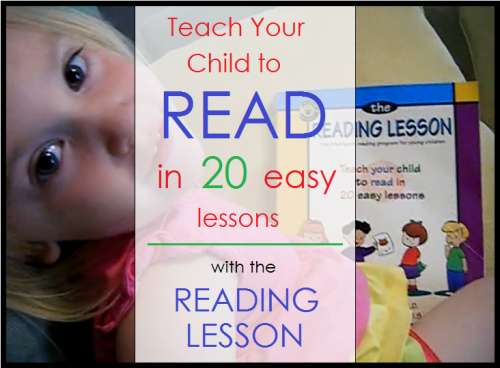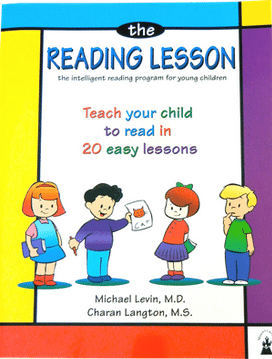I have a three-year-old little girl and just before she turned three we started using The Reading Lesson. I had been teaching her the names of the letters and she was beginning to learn some of the sounds that they make, so I thought it would be a great time to start learning to read! When I taught my son to read, I essentially created my own curriculum and found little readers to go along with what he was learning. It was a lot of work. This time around I really needed something more “open and go” since my time is more limited with two children, and The Reading Lesson fit the bill!
From the website:
The Reading Lesson is an easy-to-use recipe to make learning to read painless for both parents and children. The program is the best way to take a child with no reading skills to about the second grade level in reading. Never-too-hard and never-too-easy, step-by-step the lessons teach phonics and build the sight vocabulary. We make phonics easy without flashcards or worksheets – everything you need is right here in one book.
Teaching Reading with Phonics
If you were to ask me what the most important thing is for teaching children to read, I would say teaching using phonics. Giving your child the tools they need to decipher any new word is so important! The Reading Lesson uses a “structured phonics teaching method” (from the back cover of the book). Each lesson introduces a few new phonograms to your child and then provides lots of practice for them to master the new sounds.
The Reading Lesson instructs your child to point to each phonogram in a word, saying each sound as they go. This really helps a child stay on track and be confident in what they are reading. Each word has little line under each phonogram, showing your child where they should point. As the lessons progress, they take the lines out from under the words that your child has already had plenty of time to master.
How to Use The Reading Lesson
Don’t let the title fool you, your child will not be finished with this book after 20 times of sitting down with you. There are 20 chapters in the book, each having its own new sounds that it introduces, but each chapter will most likely take your child a few sessions to get through. Being that my daughter is just three years old, we probably are moving extra slowly, but each child will have their own pace.
I typically sit down three times a week with my daughter to work on these lessons. I set the timer for 15 minutes and go through as many pages as we can in that time. This has worked really well for us. There is no pressure to get through a certain number of pages or to finish a chapter. We just read until the timer goes off.
There are a variety of activities to help your child learn the new sounds, but nothing that takes you away from the book. For example, on one page your child might be pointing to single letters saying their sounds, then on the next page they will be matching new words to simple pictures. Before you know it, your child will be reading short sentences and then every few pages, a short story.
The progression in natural and the format is simple. This is one subject that you, mom, won’t have to prepare to teach!
Here is my daughter going through a typical reading lesson. We take a very relaxed approach, which you will see =) You will also notice that she has some trouble with her “th” and “s” sounds and we are working on that!
Some Final Thoughts about The Reading Lesson
- I love the simple layout of the book. There is nothing flashy to distract your child. The pictures are simple and effective.
- I love that I do not have to put any work into teaching this. I simply have my daughter go get the book and we just continue right where we left off.
- The lessons naturally progress from very simple to second grade level paragraphs. Your child won’t even notice that they are reading more complex words!
- It teaches many different phonograms and rules without pointing them out as such. This makes it non-threatening to your child.
- Some rules they do not teach, but just have the child learn the word as a sight-word. I don’t like this, but it is easy enough to just add a sentence of explanation, that I am still very happy using the book.
- The book is rather heavy for a small child. It would be more easily handled if it was spiral bound or sold as each lesson being its own separate small book.
- The book does not introduce capital letters until quite a ways in. Sentences look a bit odd beginning with lower case letters. I don’t see the problem with teaching from the start that sentences begin with capital letters, but it’s no big deal.
- I really like how they work things like teaching punctuation in naturally throughout the book.
- It comes with a neat computer program that my daughter always looked forward to doing at the end of each lesson (you could also use it to introduce the new sounds at the beginning of each lesson).
Extra Goodies
- Try the first 2 lessons (chapters) FREE!
- Giggle Bunny’s Storybook
- The Reading Lesson Animated CD
- Sounds of Letters DVD
- and lots more!
~written by Amy Maze, Living and Learning at Home



I’m so excited to read your review! I’ve been looking forward to this one!! It sounds really great!
Yea! If you have any questions that I didn’t address, feel free to ask =)
We love this book and are just about to finish it. I was wondering what, if anything, you used after this book. I would love it if they had a follow-up to it but I don’t think they do. Thanks!
Thank you for sharing this.
I have a question: have you ever tried the 100 lessons to teach to read? Because I would like to know what the difference is, and why either book is better, if at all? If you can’t answer this, it’s okay. I am just wondering as we are using the 100 lesson book. I had to put it aside with my first, and am now trying it with my second. She likes it, but I am still not keen on it.
Any thoughts?
I’m sorry, but I have not used 100 lessons…
I do like that this book is not broken into daily lessons, so you simply do as much as you want to in a day. Also, it takes a child to 2nd grade reading level. I’m not sure what 100 lessons goes to, but that might be a difference.
I saw The Reading Lesson at my library last time I was there, so you might check your library if you wanted to flip through a copy to see what you think.
Hi Amy – thanks for taking the time to write up this review!
It’s interesting how little thought goes into ergonomics in these programs! Big/heavy books are quite common – I think the publishers have an image of Parents cuddling their child on thier lap whilst working through the lesson of the day, perhaps with some classical music in the background and a dog sitting attentively at their feet…
…unfortunately the real world requires more flexibility and consideration!
Kate,
You are right, the book is big and heavy for little hands. Honestly, if I ever make the time, I would probably cut the binding off and make a spiral bound book for each chapter.
I think you are off, though, thinking that your picture isn’t possible. Lessons only need 10-15 minutes and the parent must be there with the child. I do sit on the couch with my daughter (as you can see in the video) to do these lessons. Any parent teaching their child how to read is going to need to set aside a few minutes each day to focus on that child. I don’t think that 10-15 minutes is more than any parent could give up for the sake of teaching their child to read. Other children could simply have reading time themselves, or play time if they are younger.
I guess I’m not sure what kind of flexibility and consideration you are hoping for. Honestly I don’t know another reading program that is more flexible. Any 10 minutes of your day and all you need is the book. You could even take it to an older child’s piano lesson or outside on a blanket…or keep it at the school table. The large book concern, though, I do understand =)
Sorry, I didn’t mean that the picture isn’t possible – just that it’s not the *only* situation in which books are read!
We spend time with our 2 1/2 yo daughter every night in a scenario much like the one I described (minus the dog) and I think it’s one of the most important things I can do as a mother – and have said as much in posts on other forums. It combines mommy-and-daddy-time, with attention, reading, learning, routine, stories and active discussion.
But there are times when she wants to pick up a book on her own and look through it or recognise letters/words on her own. (She even likes showing books to her younger brother when they’re playing together)
For us, this self-led learning is catered for (at the moment) with the Reading Eggs app (we liked it so much I even set up a site to spread the word at http://rewardingreading.com ). But we’re always on the lookout for other things that can encourage the love of learning and I think I might need to check out this 20 lessons book soon too!
We don’t have a dog either =) I think it’s great that you are being so purposeful with your daughter and hope that you find lots of great resources to help you along the way!
I think the progression of the lessons and the simple layout would really help kids a lot. It’s so easy for the little wiggly ones to get distracted or overwhelmed.
I am new to all of this, but thinking about homeschooling! My oldest is 2.5, and just watching your video is so much fun! She is SO PRECIOUS and does such a fabulous job!! This is very encouraging! 🙂
I’m so glad this was encouraging to you! It’s fun to think about plans for the kids, isn’t it? Enjoy your children today!
Most reading lessons targeting ways for a parent to learn how to teach their child how to read can make the difference between having a good start for the learning of a child or not. I like to make it fun for my kids to learn by use of fun activities.
Regards
Dani Rren
You are right, activities are a great supplement to any educational program. Thanks for the comment!
I have been using the book for my son who is a semi bilingual. After he finishes the book, what level he can go to? Beside the book, we use workbooks and Noah Webster’s Reading Handbook too. If you have any suggestions, please let me know. Thank you.